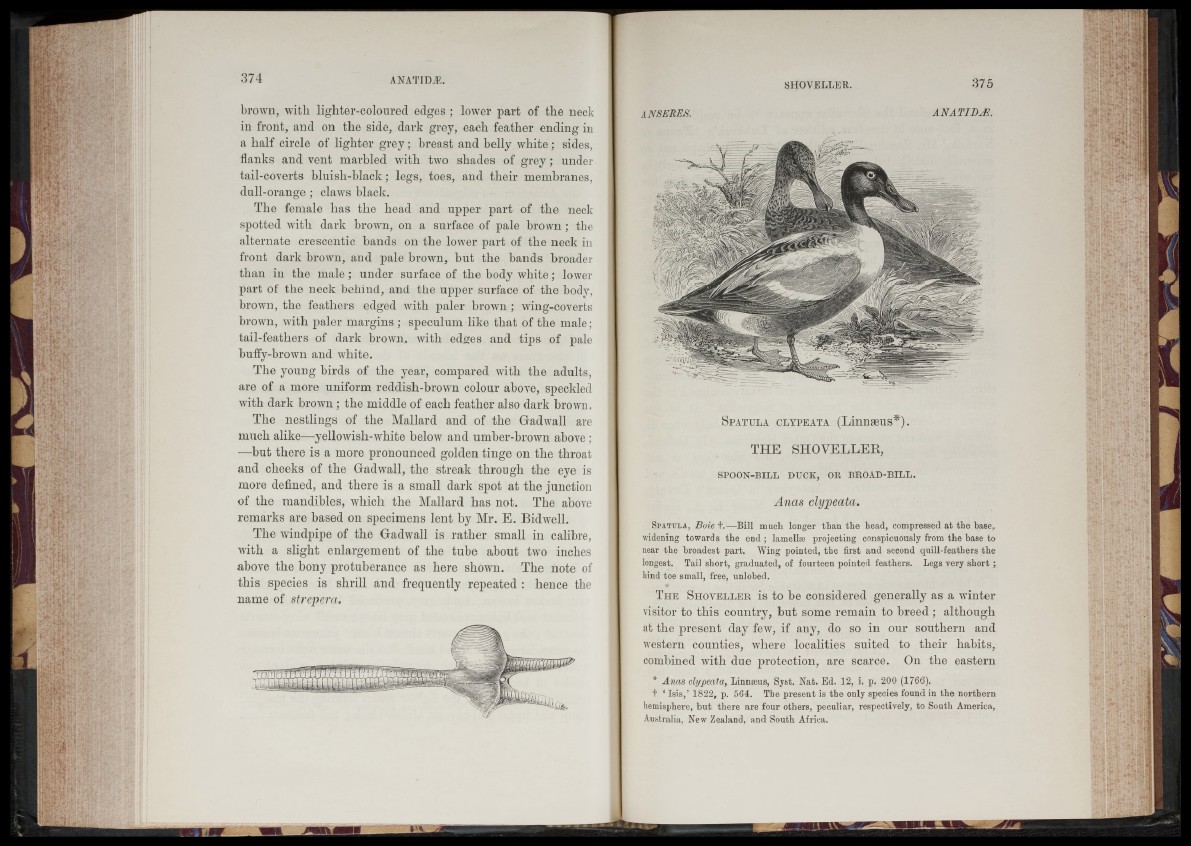
brown, with lighter-coloured edges ; lower part of the neck
in front, and on the side, dark grey, each feather ending in
a half circle of lighter grey; breast and belly white; sides,
flanks and vent marbled with two shades of grey; under
tail-coverts bluish-black; legs, toes, and their membranes,
dull-orange ; claws black.
The female has the head and upper part of the neck
spotted with dark brown, on a surface of pale brown ; the
alternate crescentic bands on the lower part of the neck in
front dark brown, and pale brown, but the bands broader
than in the male; under surface of the body white; lower
part of the neck behind, and the upper surface of the body,
brown, the feathers edged with paler brown ; wing-coverts
brown, with paler margins ; speculum like that of the male;
tail-feathers of dark brown, with edges and tips of pale
bufly-brown and white.
The young birds of the year, compared with the adults,
are of a more uniform reddish-brown colour above, speckled
with dark brown ; the middle of each feather also dark brown.
The nestlings of the Mallard and of the Gadwall are
much alike—yellowish-white below and umber-brown above;
—but there is a more pronounced golden tinge on the throat
and cheeks of the Gadwall, the streak through the eye is
more defined, and there is a small dark spot at the junction
of the mandibles, which the Mallard has not. The above
remarks are based on specimens lent by Mr. E. Bidwell.
The windpipe of the Gadwall is rather small in calibre,
with a slight enlargement of the tube about two inches
above the bony protuberance as here shown. The note of
this species is shrill and frequently repeated : hence the
name of strepera.
AN SERES. A NAT ID AA
S pa tu la clypeata (Linnaeus*).
THE SHOVELLER,
SPOON-BILL DUCK, OR BROAD-BILL.
Anas clypeata.
Spatula, Boief.—Bill much longer than the head, compressed at the base,
widening towards the end; lamellae projecting conspicuously from the base to
near the broadest part. Wing pointed, the first and second quill-feathers the
longest. Tail short, graduated, of fourteen pointed feathers. Legs very short ;
hind toe small, free, unlobed.
T h e S h o v e l l e r is to be considered generally as a winter
visitor to this country, but some remain to breed ; although
at the present day few, if any, do so in our southern and
western counties, where localities suited to their habits,
combined with due protection, are scarce. On the eastern
* Anas clypeata, Linnaeus, Syst. Nat. Ed. 12, i. p. 200 (1766).
t ‘ Isis,’ 1822, p. 564. The present is the only species found in the northern
hemisphere, but there are four others, peculiar, respectively, to South America,
Australia, New Zealand, and South Africa.